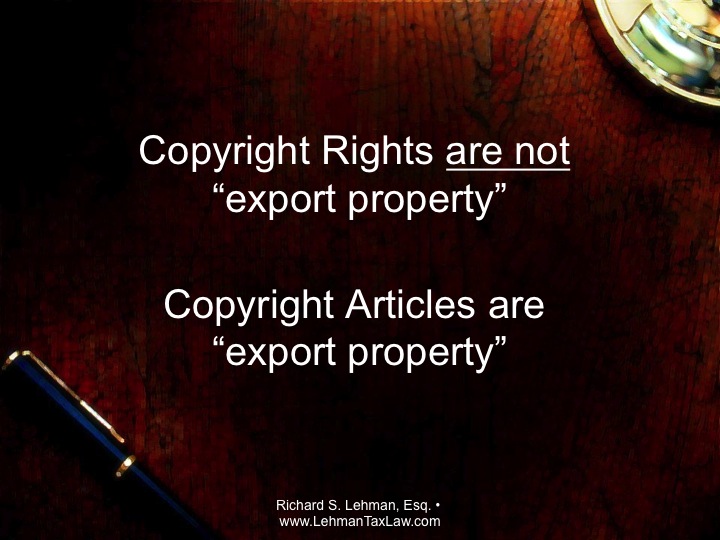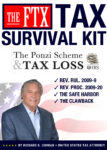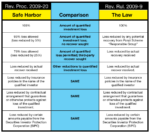IC-DISC and United States Exporting of Computer Software, Internet Sales and Licenses

The Export Disc Corporation Computer Software And Internet Sales And Licenses
By Richard S. Lehman, Esq
The IC-DISC has been approved as an acceptable tax planning entity for the export of American produced computer software and programs as early as 1985. In 1998, a very detailed set of Treasury Regulations were issued that have added certainty to this area of the law.
Before the issuance of the Software Regulations, there was uncertainty about the taxation of computer program transactions. Computer programs did not fit traditional tax principles. Computer programs are usually sold pursuant to “license” or “user agreements”. A computer program transaction is unlike a sale of a physical object since the value of the program copy far exceeds the value of the physical medium on which it is transferred. Computer programs, in fact are transferred electronically. Often, there is no physical medium at all.
For purposes of determining the applicability of the DISC to computer software exports, two key analyses are often required. First, (1) is the software “export property” for DISC purposes and (2) is the software product’s source of income “from without the U.S.”? Is the product for use, consumption or sale without the U.S.?
In a technical advice memorandum in 1985, the I.R.S. issued guidance on the issue of whether certain computer software programs constituted “export property” for DISC purposes. That Technical Advice Memorandum reviewed the term “export property” for DISC purposes in depth and determined in its holding that computer software could indeed be “export property”. In doing so the Technical Advice not only reviewed the legislative history of the DISC rules it also pointed out the distinctively different treatment that “patents, inventions, models, decisions, formulas, or processes whether or not patented, copyrights, goodwill, trademarks, trade brands, franchise or other like property” receive under the DISC rules, as opposed to the treatment of “films, tapes, records or similar reproductions, for commercial or home use.”

Copyright law is the basis for the Software Regulations. The Regulations are based on the concept that it is possible to categorize a computer program transaction by analyzing the copyright rights transferred. Like many other tax laws, it is generally accepted that the taxation of payments made pursuant to a contract is determined based on an analysis of the contract’s substance, without regard to the labels.
The most important distinction created by the Software Regulations is the distinction between copyrighted articles and copyright rights. This basic distinction arises from copyright law. Copyright law distinguishes between the copyright itself, which grants the owner certain rights, and a copy of the copyrighted work. The Copyright Act grants to copyright owners the exclusive right to “reproduce the copyrighted work in copies”. The Copyright Act states that “Ownership of a copyright, or of any of the exclusive rights under a copyright, is distinct from ownership of any material object in which the work is embedded.”
The Copyright Rights are not “export property” for DISC purposes while the Copyright Articles are “export property”.
The “Export Property” analysis in the I.R.S. Technical Advice Memorandum is enlightening.
The computer software considered as an example to show the nature of “Computer Articles” was described in the Technical Advice Memorandum as follows:
Mr. X develops, markets and services standardized computer software on a worldwide basis. The software consists of computer programs on magnetic tape. Computer programs are coded instructions to operate the computer to process data in a specified manner.
Mr. X’s computer software products are manufactured in the following manner. Computer programmers develop a computer program, which is referred to as “source language software” (“source code”). The source code is highly confidential and kept under strictly controlled security at all times. The modifications to the computer programs that are required to keep the software up to date with changing technology and user requirements are made to the source code. The source code is processed by a computer into a master recording, which contains the magnetic impulses a customer will receive. Unlike the source code, the master recording cannot be used to modify a software program. The products that Mr. X markets are tapes made from the master recordings.
The Export Property Analysis
Export property is defined to mean, in general, property that is:
- Manufactured, produced, grown or extracted in the United States by a person other than a DISC,
- Held primarily for sale, lease, or rental, in the ordinary course of trade or business, by, or to, a DISC, for direct use, consumption, or disposition outside the United States and
- Not more than 50 percent of the fair market value of which is attributable to articles imported into the United States.
Export property does not include “patents, inventions, models, designs, formulas, or processes, whether or not patented, copyrights (other than films, tapes, records, or similar reproductions, for commercial or home use), good will, trademarks, trade brands, franchises, or other like property . . .
Although a copyright such as a copyright on a book does not constitute export property, a copyrighted article (such as a book) if not accompanied by a right to reproduce it is export property. The legislative history of the DISC states the following: “Although generally the sale or license of a copyright does not produce qualified export receipts (since a copyright is generally not export property), the sale or lease of a copyrighted book, record, or other articles does generally produce qualified export receipts”.
Computer software can be export property. Computer software tapes are akin to the copyrighted books, which qualify as export property. Computer programs are standardized programs that are manufactured in the United States by a person other than a DISC and then marketed outside the United States. This is not selling the source code or master recording. Those purchasing or leasing programs do not have the right to reproduce the software.

Copyright Rights
The regulations distinguish between transfers of copyright rights and transfers of copyrighted articles based on the type of rights transferred to the transferee. The transfer is classified as a transfer of a copyright if, as a result of a transaction, a person acquires any one or more of the following rights:
(1) the right to make copies of the computer program for purposes of distribution to the public by sale or other transfer of ownership, or by rental, lease or lending;
(2) the right to prepare derivative computer programs based on the copyrighted computer program;
(3) the right to make a public performance of the computer program; or
(4) the right to publicly display the computer program.
Transfers of Computer Programs
The regulations provide rules for classifying transactions involving the transfer of computer programs. A computer program includes any media, user manuals, documentation, database or similar item if the media user manuals, documentation, database or similar item is incidental to the operation of the computer program.
A copyrighted article is defined as a copy of a computer program from which the work can be perceived, reproduced, or otherwise communicated, either directly or with the aid of a machine or device. If a person acquires a copy of a computer program but does not acquire any of the four copyright rights, the transfer is classified as a transfer of a copyrighted article.
In general, a transfer of a computer program is classified in one of the following ways.
- A sale or exchange of the legal rights constituting a copyright (which generates income sourced according to the rules for sales of personal property);
- A license of a copyright (which generates royalty income);
- A sale or exchange of a copyright article produced under a copyright (which generates income sourced according to the rules for sales of personal property);
- A lease of a copyright article produced under a copyright (which generates rental income).1
1Additional rules allow for the classification of a transfer as partially a transfer of services or of know-how. The provision of know-how, in which the transferor retains continuing use of the know how transferred, is presumably most like a license of a copyright.
The following are four examples from the Treasury Regulations that describe the four types of transactions.
Example 1 – Sale of Copyright Article
A U.S. corporation, (the “U.S. corporation”) owns the copyright in a computer program, (the “Program”).
The U.S. corporation, (the “U.S. Corporation”), makes the Program available, for a fee, on a World Wide Web home page on the Internet. Mr. P, a resident of Country Z, in return for payment to the U.S. Corporation, downloads the Program X (via modem) onto the hard drive of his computer. As part of the electronic communications, P signifies his assent to a license agreement.
Mr. P receives the right to use the program on his own computers (for example, a laptop and a desktop). None of the copyright rights have been transferred in this transaction. P has received a copy of the Program. P has acquired solely a copyrighted article.
P is properly treated as the owner of a copyrighted article. There has been a sale of a copyrighted article rather than the grant of a lease.
Example 2
The facts are the same as those in Example 1, except that the U.S. Corporation only allows Mr. P, the right to use the Program for one week. If P wishes to use the Program for a further period he must enter into a new agreement to use the program for an additional charge.
P is not properly treated as the owner of a copyrighted article. There has been a lease of a copyrighted article rather than a sale.
Example 3
A U.S. Corporation, transfers a disk containing the Program to a Foreign Corporation (the “Foreign Corporation”) and grants the Foreign Corporation an exclusive license for the remaining term of the copyright to copy and distribute an unlimited number of copies of the Program in the geographic area of the Country in which the Foreign Corporation makes public performances of the Program and publicly displays the Program.
Applying the all substantial rights test, the U.S. Corporation will be treated as having sold copyright rights to the Foreign Corporation. The Foreign Corporation has acquired all of the copyright rights in the Program and has received the right to use them exclusively within the Foreign Country.
Example 4
A U.S. corporation, transfers a disk containing the Program to a Foreign Corporation in Country X and grants the Foreign Corporation the non exclusive right to reproduce (either directly or by contracting with another person to do so) and distribute for sale to the public an unlimited number of disks at its factory in return for a payment related to the number of disks copied and sold. The term of the agreement is two years, which is less than the remaining life of the copyright.
There is a lease of copyright rights since copyright right have been assigned but for a limited time period only.
The Source of Income Analysis
Once it is determined that a computer program is a copyright article and thus “export property” for DISC purposes; then the issue is to determine whether the Software Program is being sold for use, consumption of disposition outside of the U.S. This analysis depends upon the “source of income” rules.
Generally under the current rules, the source of income from sales of property depends to varying extents upon both the type of property and whether the property sold or leased is “inventory property”.
Income from the lease of a copyright article must also fit this definition of non U.S. source of income.
The user of the computer program is particularly important in the international context. Income earned from commerce between countries must be assigned a source under rules. This requires a determination of whether the transaction is a sale of inventory, a rental of property, a license or sale of intellectual property or the provision of services.
The regulations focus on (i) acknowledging the special circumstances of computer programs, (ii) distinguishing between transactions in copyright rights and in copyrighted articles, and (iii) focusing on the economic substance of the transaction over the labels applied, the form and the delivery mechanism.
The Software Regulations provide explicit guidance on how to source income arising from transactions categorized under the regulations by cross referencing existing source rules.
The regulations provide that income from transactions that are classified as sales or exchanges of copyrighted articles will be sourced under the sections of Internal Revenue Code that determine if income is earned in the United States for tax purposes or earned outside of the United States. Income from the leasing of a computer program will be sourced under different Internal Revenue Code sections.
Source of Income for Sales of Copyrighted Articles
A transfer of intangible property is a sale if the actual facts and circumstances support the fact that the transferor has transferred “all substantial rights” to the computer software property. A perpetual and exclusive license of intangible property is considered to be a transfer of “all substantial rights” is also treated as a sale, rather than as a license, for tax purposes. All the facts and circumstances are reviewed to determine whether the transaction transferred “all substantial rights” to the property in question.
A sale of a copyrighted article occurs if sufficient benefits and burdens of ownership have been transferred to the buyer, taking into account all facts and circumstances. This is the same test that generally is applied to determine whether transfers of tangible personal property are sales or leases.
The source of income generated by the sale or exchange of a copyrighted article often depends upon whether the sale took place within or without the United States. The Software Regulations provide that the place of sale is determined under the “title passage rule”.
The governing regulation state that “a sale of personal property is consummated at the time when and the place where, the rights, title and interest of the seller in the property are transferred to the buyer”. The sale shall be deemed to have occurred at the time and place of passage to the buyer of beneficial ownership and the risk of loss.
As to the issue of determining the place of sale under the title passage rule, the parties in many cases can agree on where title passes for sales of inventory property generally.
Application of the Title Passage Rule
As described above, the source of income generated by the sale or exchange of a copyrighted article often depends upon whether the sale took place within or without the United States. The place of sale is determined under the title passage rule. The Software Regulations recognizes that typical license agreements do not refer to a transfer of property and an electronic transfer is generally not accompanied by the usual indicia of the transfer of title.
Application of the Title Passage Rule
There are important categories of copyrighted article transfers for DISC purposes: (i) a transfer of tangible property, such as a tangible medium in which the copyrighted article is embodied, and/or a hard copy of user manuals and documentation; (ii) (e.g., electronically transmitted copyrighted articles without any hard copy of user manuals and documentation). Either one of these can be the subject of a sale.
To comply with the passage of title rules, a DISC may consider language such as: Title to this computer software program, shall pass outside the United States in its agreements when tangible property is being transferred. If non tangible property is delivered, the DISC taxpayers could consider documentation for foreign users (which could be a contract to sign or terms consented to electronically) that states that the vendor’s delivery obligation shall be complete and risk of loss with respect to the copyrighted article shall pass at the time the program is copied onto the recipient’s computer at the end user’s location.
Partial Transfer of a Copyright Article: A Lease
If less than all of the benefits and burdens associated with a copyrighted article have passed to the transferee, the Software Regulations treat the transaction as a lease. Copyright articles can be leased as well as sold. Computer programs do not involve the risk of physical deterioration or physical destruction but they do have the risk of technological obsolescence. If this risk is assumed by the transferee, generally through a transaction in which the transferee makes a single payment in return for the right to use the program copy in perpetuity, then the transferee has assumed the risk of obsolescence and should be treated as the owner of the program copy.
However, if the transferee instead makes periodic payment and can cease its use of the program when it chooses, then the transferee has not assumed the relevant benefits and burdens of ownership and the transaction should be considered a lease.
Lease and Rental Source of Income
Under the Software Regulations, income derived from the rental of a copyrighted article is sourced under Section 861(a)(4) and 862(a)(4). As a general rule, rents and royalties are sourced to the place where the leased or licensed property is located, or where the lessee or licensee uses, or is entitled to use the property.
Leased property is used where it is physically located at the time of its use by the lessee. Therefore a computer program copy that is “rented” under a limited duration license should be considered to be used at the place where the computer that hosts the program is physically located while the lessee uses the program. If the copy resides on the lessee’s computer, the lessor will need to know where that computer is located in order to source its rental income.






